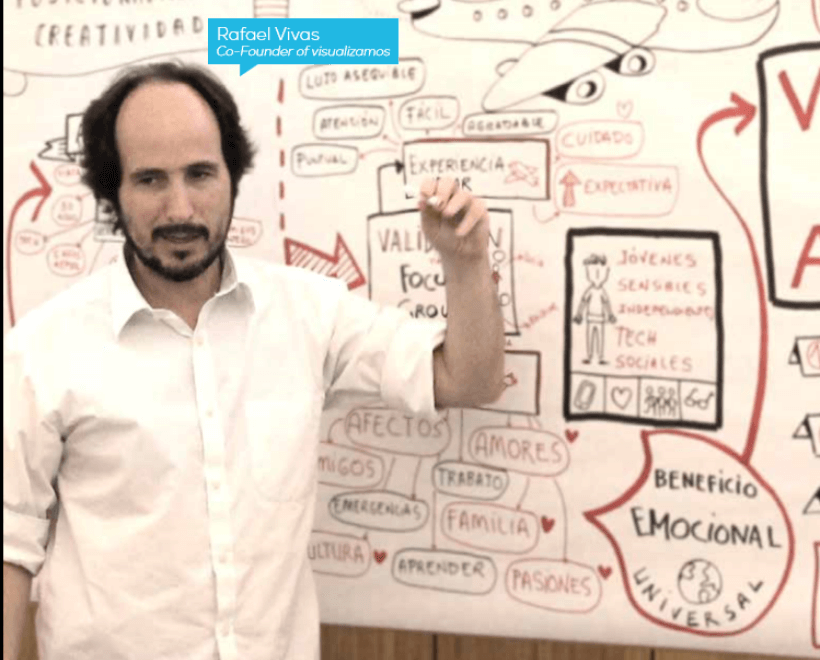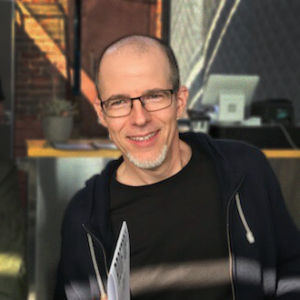Visual Thinking In Education
I was pleased to find Rafa Vivas in a small house near the Alfonso XIII Subway station in Madrid. "The house is rented, says Rafa, "It belongs to a professional who is working abroad in China...". I walked through a little garden entry, I then got access to a spacious living room with wooden floor that received light from the bottom glass gazebo, overlooking the interior garden, a clean work table, capable of hosting a medieval banquet, and a shelf full of markers, post- its, and colored dots... Rafa invites me to wait on a sofa that looks out onto the terrace. The atmosphere is bright, lively, and quiet. Upstairs the rest of the team is working, in silent. Outside the birds are singing and the sun is dropped on the garden chairs, playing with drawing stripes on their backs. I'm waiting quietly, leaving myself being engulfed by the sofa, ready to reach Nirvana, when Rafa rescues me to start the interview about visual thinking in education.
Educational Community: Curious For Visual Thinking
"Since quite time ago", Rafa says", "from almost the beginning of commercial activity, we realized that this -visual thinking- aroused great interest in the educational community. The interest came mostly from the instant search that search engines do in order to find new ways of transmitting knowledge and motivating students, and also to understand it better.
From the first moments of our company, we have worked with teachers who invite us to presentations on teaching and pedagogy. For example, the University of La Rioja invited us in the degree of Pedagogy to talk with teachers. We see that there is a lot of interest from the very beginning. For me, the interest is divided into two different areas; I'm trying to convey to the educational community that there are two different fields of what visualization is:
1. On one hand, there is everything related to better understanding. That's a field we have not opened; visual communication has been around a lot, and in this sense we have not done more to emphasize its importance. Textbooks are not as they were before. Books used by my children have nothing to do with the ones I used for years. This trend that exists and is universal to what is a greater visual load, also occurs in education. And as we are dedicated to visualization, they rely on us to follow this trend. However, I don't think this is the greatest richness of what this methodology of the artistic use is.
2. For me, the greatest contribution is to get teachers and students that are able to think with pictures, and this is hard, almost unnatural. For example, when working on a project, we continue to imitate things that we will be doing in business: We are still having students sit around a table and encouraging them to discuss and agree on something."
Learning To Think With Images
"Imagine that kids have as an assigned project to choose a mammal, working an entire quarter on the animal, and delving into a number of things that are good for the subject. This was called 'unique issues' before. Now they call it 'We will work on projects'. And this project is exploited to explain many things by the kids' research. Because if they are investigating and they all agree, then we will increase their motivation.
All this is fine, but the visual thinking methodology is not used in this new way of working and thinking. It is only used for the final communication, i.e. 'The deliverable that you have to do to present the results of your project in the classroom has to be visual'. But you still have them sit around a table to discuss why it is better to work with the gazelle than with the buffalo or the giraffe. 'Put yourself in agreement'."

"We work mainly with companies. What we see is that in business there is a great lack of thinking and team working, and also a contempt of visual tools.
What I would do is have many guys sit around a table and encourage them to discuss while visualizing: To be able to draw a buffalo and see why the buffalo deserves to be our animal. When I say 'draw', it can also be 'Let's take pictures, let's see, let's agree, but in a visual way'.
When people work in organizations, they are working on a level at the project that is so little grounded, that is surprising: How is it possible that this problem with children is getting transferred to the business world? It would be, for example, something like: 'Our audience is configured by males and not females.' At a meeting, they begin to argue about it: 'No, I do not think you're right, I think our target audience are both men and women'; 'No, I think not, I think there are 30 year-old women only'. Progress is being made in that discussion, and no one is able to get up and say: 'Let's see: This is a woman; let's give it a name. Do you think that this is our target audience? Let's see how she is, how she dresses, etc. We will try to reach an agreement through images'. This is an important part of our work.
Normally, communication is allowed to be visible. Books are visible, PPT are visible; but in work processes, it is amazing to see how the same patterns are repeated. For us, one of the challenges is to transform the way you work through visualization."
Location Maps, Timelines, Innovation Maps, And Motivational Maps
"This looks great with the example of Napoleon: Napoleon Bonaparte, at an executive committee of a large current company, when seeing the professionals, who sometimes go with a dossier when they have to discuss something very complicated, at any given time of the meeting, he would rise and say: 'Let's see: Where is the map? I've been all my life making decisions based on maps.' All his generals then would look at the maps, discriminate the armies of each nationality by colors, and understand the strategy. They would all have the same picture. So, when going to the battlefield, all of them would have the same mental picture and everyone would know what they would have to do. Not here: Here people work with PDFs of 100 pages, but nobody cares about making a strategy map.
What we essentially do are maps. We work with timelines that follow the user experience when performing a task. Through all stages, we see in pictures what happened, and we put what client expected in each of these microsteps and what happens to them. Using small icons, we see if there is absolute agreement between what the customer expects and what happens; in this case we include a sun icon, or, otherwise, we put a storm icon. As all these things occur, we add through vignettes what the client thinks about and, finally, we create a client emotional line, ranging from very happy to very depressed, to see at every stage what is happening and how we have scored. There are moments of depression, there are great moments, and so we have a vision of how the company or the product or the service interacts with the client at every moment of this curve of happiness. There are many companies that do not have maps; they are discussing their strategy without having a map of the situation in front of them.
We also do maps of innovation, where we propose a new plan with different steps in the sequence of customer interaction with the company.
We also create maps where the motivations of a specific target are discovered. Different islands are drawn: The territory of happiness, the territory of the experiences, the material world, friendships, family, institutions, the online world... In this case, we made a template where all these things are present; if we have an idea about what further action we will perform in a particular month, we score it according to these 'insights'."

"These are the maps that we do. The way we manage the business world is by doing maps for businesses to make better decisions.
Turning to education, viewing it in communication and teaching things in a more visual way seems very interesting. But for me it is much more revolutionary to teach young guys that they can learn to think visually, they can work together, they can make decisions through visualization using mental maps."
Mental Maps: Best In A Team
"The mental map in education is already widespread; unfortunately not in Spain, but in other countries is widely used as a study tool. When we were children we already used the scheme, but we are talking about a well done scheme: The mental map has rules that if you know about, it begins to make sense. As a study tool, it is very good: Students who are a little more visual will be able to confront the study of a subject with a little more fun, more graphically. A mind map cannot include only arrows and circles, it can also add drawings.
But a mind map for a team seems to me to be much more interesting. Imagine a team of kids from secondary education whose teacher says: 'Let's talk about traffic education. What I want is that instead of explaining it by the book, you get organized in groups of four, and think of an idea to drastically reduce traffic accidents.' The kids have to generate a project to promote the idea that they will be supposedly sent to the General Directorate of Traffic. They can build a mental map to see what traffic accidents depend on: The state of the road, the responsibility of the driver, the vehicle itself... They can open branches of the mind map and everything is well understood. So, they can all share the same overall picture of what causes traffic accidents.
However, work continues haphazardly: 'You have to agree on what you have to work with to reduce traffic accidents.' It is likely that this leadership is also understood as someone who stands up to draw the large map of traffic accidents on a paper, and with that map, to start working together."
Qualitative Research
"Throughout the project much information is collected, and to share that information is what visualization is good for. A qualitative study of the human being is not so much through the data, but by knowing what the 'pain' of human beings is. We use the method of interviews and focus groups much. Observation is also important.
This would apply, for example, to HR departments which need to identify and promote the talent of their workforce in the company. We are convinced that any exploration work that has the human being as the subject of study is a qualitative research, and can use these tools. For example, quantitative data must be combined with conversations, because there are things that are only detected when you have an honest conversation, or when you spend enough time observing the person.
One of the best known cases in this methodology is that of Kellogg's cereals: They wondered why women were not taking cereals; only children were eating them. Kellogg's did many surveys, but didn't discover what the reason was. Then they hired a team that was dedicated to observe what was happening at homes during breakfast. They found things that did not appear in polls; for example, many women did not have time to sit down for breakfast. So arose the Kellogg's bars. Although surveys are an essential tool, we must also talk a lot, interact, and observe.
Likewise, we can map the experience of a student in their learning process. This is combined with another methodology, design thinking. You have to see how children learn. You have to understand the challenges they have, from the student's own skin. You have to use empathy. It is very important to know that you have to not only put yourself in the shoes of the other, but also, and this is much more interesting, stop and listen to the reasons of the other. We cannot understand only from our own shoes. It is a very complicated exercise. The pain a kid feels when fails in school is understood; a kid that is automatically failing all the subjects. But you have to identify what is happening there."
The Student Travel, Unfinished
"So far, we have worked with three types of sequences:
- The customer journey.
For example in a restaurant, from entering and siting down until paying and leaving. - The patient journey.
For example with sick people, from being diagnosed with the disease until they go under a secondary treatment. - The employee journey.
New employees who join the organization, role changes.
We have never made the trip of a student, and I think it is much more important, because it is something that unites us all: We have not all gone to a five star restaurant, or have been suffering from Parkinson, or have been working for a large company, but we all share the experience or memory of having gone to school. I'd love to do it, but I do not know who is going to pay for it...
We need to make a dive to understand the ecosystem of a class; of course, it takes a lot of observation. You also have to spend the time to talk to people. I think it is essential to draw that trip also by talking with teachers and with kids. We could draw the emotional curve, the curve of happiness over a day, or throughout a school day, and to compare it in different European countries. If the average time spent at a school day in Europe is seven hours, we could compare what are the greatest moments of satisfaction.
It would also be interesting to draw the journey of a student for each of the subjects. For example, splitting the time of physical education and see how it goes in the Netherlands, what takes place in Germany, etc; it would be very revealing. A map is not only an outline: It's a lot of information of what is happening at each moment, what methodology is being used, what is waiting for the kid in each country. If something that happens in Spain and not happening in the Netherlands, it changes expectations. Imagine that in Spain this habit exists: Before taking the main activity of the physical education class, there are always 10 minutes of warming up. In the Netherlands there is not such a warming up activity, but they do have a game: They begin to warm up by playing games. Typically, games are always related to a ball. Expectations in each case are different. I am told that whenever there is physical education, the first 10 minutes are to roam around the yard and play fun games. If with both situations we get the same results, Spanish expectations are not even funny; they are rather oriented to hiding from the teacher at the locker room with others to wriggle or whatever."
Visual Thinking In Education In Europe
"I do not know if in other countries visual thinking is already being implemented. I only know that in publishing is being done. The educational publishing industry faces some challenges that are egregious, and I know that many of them are using these methodologies. They are reacting to the 'threat' of digital technology. I have no news that this is being incorporated into the classroom as a methodology.
There is something that seems surprising and no one has yet acted on it: The provision of classrooms. Classrooms remain the same as when I was little. How is it possible that the chairs are one behind the other and that people are looking at someone else’s neck? How is it possible to keep working that way? This is an absolute lack of empathy. Anyone who cares to see what kind of things the students care about would propose this provision, and yet it remains being so. I get the impression that people are getting the batteries on when they see their empire coming to an end. I have also certain that many professionals in the educational world are extremely committed to their profession, they want to change things, and are looking for new things all the time."

Visual Thinking At A Regional Level
"From my point of view, there is nothing you cannot apply visual thinking to. I think that when you do not draw, you do not have a common picture to share. If we are at a regional level, the local Minister of Education meets with representatives of school boards, representatives of parents, organizations of private, subsidized, or public schools... Imagine that lady at a meeting to discuss school dropout rates. What do you think it would happen? They begin to speak, identify the factors involved -lack of personal attention to students, immigration, inequality between communities, religion, etc.-, and everything would be floating in the air. Or, at best, a document would be drawn up with what was being mentioned.
It seems to me that if we had a team of experts in psychology and methodology like ours, and which was requested that in three months we need to draw the map of dropout rates, expose it in the room, where participants would talk about the problems identified at all times, with percentages for each type (private, concerted public) centers, then we would be working on a common picture that would allow us to build. For the meeting to be effective, it should be given the possibility of having pens in hands for everyone to participate, connecting data. They could get the photo and start having initiatives.
You can use colored dots on the map. Each color can represent a sum of money, to be distributed on the map for each type of problem identified. An exercise of co-creation is then made. Feedback can be made to identify the hierarchy of problems, you can make really practical things like sharing budgets... We reach agreement on this map, which will be the basis of the campaign."
Visual Thinking And Special Education
"In any challenge visual thinking methodology adds value; such as in special education, dropping out... Any challenge has visual thinking as an ally that adds value. The important thing is that everyone is sharing a vision. With autistic children we have even been invited to a school specialized in these situations. Autistic children in particular are extremely visual. For me, the immediate step is to build a visual library, letters, a collection of icons that allow them to focus attention. It seems to me that in a course, it can be very motivating that children who do not have this deficiency would be the makers of that visual library, for there to be an exercise in promoting plurality."
Visual Thinking And New Technologies
"With new technologies, the new way of reading is no longer sequential, turning one page after another. As we are talking about screens, it makes little sense in my view to move the book format to an electronic device. I do not want to read in my electronic device as I read a book. I want to make a spatial reading. I do not want to always read through the pages; I want to see what's up, what's down, there is a hyperlink, and in this sense, the chances of the maps are multiplied, where the depth reading will depend on the will of the reader, and it is the electronic format which allows the reader to obey or not."
Future Applications
"As a closing point, it seems to me that this is not 'a fad which is here to stay', so please introduce it in a definitive way in the classroom: It is a pity that in other countries all the kids work with mental maps widely and here in Spain there are still students who do not know what mental maps are.
Please, show stronger commitment to make things easy for students to understand what they have to study in more visual ways. And well, overall, I'd say to include the recreational component; we cannot allow to continue thinking that drawing is only for a few people. When I go to groups, I ask 'How many of you know how to draw?' and only a few raise their hands. Then I ask 'How many of you know how to write?' and they remain puzzled, thinking 'What a silly question'. None remains without raising their hands thinking 'Well, I do not raise my hand because I do not write as Vargas Llosa or Cortázar or as Miguel Delibes'. Each writes as they can, and yet no one judges the artistic value of their writing, because it is supposed to be something functional that you use to manage in your day by day, at work, at school. However, with drawing, the artistic value of the drawing is immediately put into question; so, if you're not an artist, you cannot draw. The boys no longer raise their hands because they have a good hand writing; each has the lyrics they have. Likewise writing is necessary, drawing is essential. We are talking about intangibles to be represented in a very simple way, to turn them into tangible things."
Yes To Books "With Little Drawings"
"I conclude with an anecdote: Every end of the course year, I go for the qualifications of my children. It is a time when parents can chat with the tutor. I remember perfectly how, when one of my children was ten, we went to the school at the last day for the qualification, starting with our eldest son. His tutor told us our son had passed everything, but not with much brilliance, and that if he had to give us a tip for summer is to read a lot, so he would get used to reading. And then he added: 'But please, do not give him pictured books.' I am an illustrator of books and my wife told me: 'No, please, Rafa, behave.' I said nothing. It was very sad to me that someone authorized to be a teacher would give this kind of message. Drawings are essential. I am a lover of drawings. Pictured books are not just for children; they have a double reading. A good illustrated book is telling you things through two different channels; with the reading experience and with the visual world... There are so many good things in drawings, in addition to promoting the habit of reading! I read a lot, a lot of essays and many novels, and I started by reading comics. It seems so bad to me that these things happen, that I hope they will not continue to take place."









